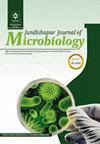Examining the Frequency of Carbapenem Resistance Genes and Its Relationship with Different Classes of Integrons Including Classes I and II in Pseudomonas aeruginosa Isolates of Burn Patients
IF 0.5
4区 医学
Q4 MICROBIOLOGY
引用次数: 0
Abstract
Background: Pseudomonas aeruginosa is one of the most important opportunistic pathogens causing hospital infections. Objectives: This study aimed to investigate the abundance of integrons and the pattern of resistance to carbapenems (metallo-β-lactamases including Spm, Imp, and Vim) and its relationship with the presence of integrons classes I and II in P. aeruginosa isolates. Methods: This study was conducted on 73 samples of P. aeruginosa isolated from burn wounds of patients admitted to the burn center of Velayat Hospital, Rasht, Iran. To confirm the phenotype of P. aeruginosa, Gram staining and diagnostic biochemical tests, including oxidation-fermentation (OF), pigment production, citrate utilization, catalase activity, oxidase test, and growth at 42°C, were used. After identification and confirmation, molecular diagnosis was conducted to identify strains producing genes classes I and II using the polymerase chain reaction (PCR) method. Results: In this research, the frequency of carbapenem resistance genes in clinical isolates of P. aeruginosa was found to be zero, 13.7%, and 21.9% for blaSpm, blaImp, and blaVim genes, respectively. Integrons of classes I and II were present in 53.4% of isolates of class I and 17.8% of isolates of class II. Also, 4.1% of the total integrin-positive isolates had both integron classes. Conclusions: There was a statistically significant relationship between class I integron and the blaImp gene. Importantly, the mechanisms of other integrons play a role in the development of resistance and the presence of these genes involved in this project.研究烧伤患者铜绿假单胞菌分离物中碳青霉烯耐药基因的频率及其与包括 I 类和 II 类在内的不同类型整合子的关系
背景:铜绿假单胞菌是导致医院感染的最重要的机会性病原体之一。研究目的本研究旨在调查铜绿假单胞菌分离株中整合子的丰度、对碳青霉烯类(金属-β-内酰胺酶,包括 Spm、Imp 和 Vim)的耐药性模式及其与整合子 I 类和 II 类存在的关系。方法:本研究对从伊朗拉什特 Velayat 医院烧伤中心收治的烧伤患者伤口中分离出的 73 个铜绿假单胞菌样本进行了研究。为确认铜绿假单胞菌的表型,采用了革兰氏染色法和诊断性生化测试,包括氧化发酵(OF)、色素生成、柠檬酸利用、过氧化氢酶活性、氧化酶测试和 42°C 生长。经鉴定和确认后,采用聚合酶链式反应(PCR)方法进行分子诊断,以确定产生 I 类和 II 类基因的菌株。研究结果本研究发现,铜绿假单胞菌临床分离株的碳青霉烯耐药基因频率分别为 0、13.7% 和 21.9%,其中 blaSpm、blaImp 和 blaVim 基因的频率分别为 0、13.7% 和 21.9%。53.4% 的 I 类分离物和 17.8% 的 II 类分离物含有 I 类和 II 类整合子。此外,4.1%的整合素阳性分离物同时具有两种整合素。结论I 类整合素与 blaImp 基因之间存在统计学意义上的显著关系。重要的是,其他整合素的机制在抗药性的产生中起着一定的作用,这些基因的存在也与该项目有关。
本文章由计算机程序翻译,如有差异,请以英文原文为准。
求助全文
约1分钟内获得全文
求助全文
来源期刊

Jundishapur Journal of Microbiology
MICROBIOLOGY-
CiteScore
1.30
自引率
0.00%
发文量
56
审稿时长
6-12 weeks
期刊介绍:
Jundishapur Journal of Microbiology, (JJM) is the official scientific Monthly publication of Ahvaz Jundishapur University of Medical Sciences. JJM is dedicated to the publication of manuscripts on topics concerning all aspects of microbiology. The topics include medical, veterinary and environmental microbiology, molecular investigations and infectious diseases. Aspects of immunology and epidemiology of infectious diseases are also considered.
 求助内容:
求助内容: 应助结果提醒方式:
应助结果提醒方式:


